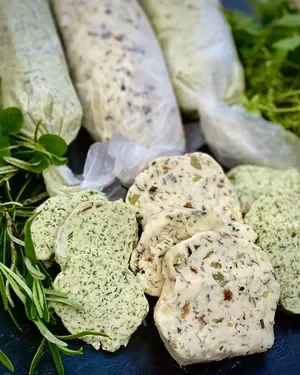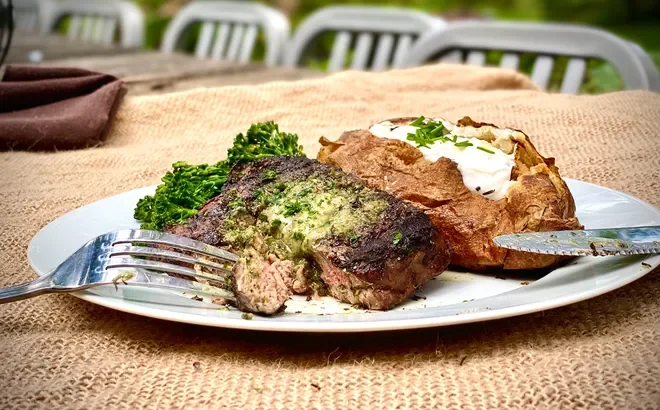(Compound) Butter Makes It Better
Special to The Detroit News
“I’m so tired of needing only a tablespoon of fresh thyme for a recipe and throwing out the rest. Where else can I use it, or can it be saved?”
My friend Lori Goldberg was definitely asking the right person. As a trained chef with a large patio garden, I am routinely a personal cooking coach. Conversations like this are pure joy for me. I can talk about food and cooking forever. I reassuringly poured her a glass of wine as we talked in my kitchen and told her, “The doctor is in!”
I love using fresh herbs. They are an amazing flavor enhancer for so many things, but Lori was right to be frustrated. They are delicate and expire quickly, which makes them costly if most of the bunch is left in the fridge to go bad.
“The trick to working with fresh herbs is cleaning and storing them properly, knowing where you can use them, and having a way to preserve the rest,” I told her.
One way to use up those fresh herbs is to make what’s called compound butter. You mix finely chopped herbs with softened butter and it can be used to finish grilled meat, fish or poultry or vegetables. Even better, compound butter can be used as soon as it’s made, refrigerated again or even tightly wrapped and frozen.
I reached for a few compound butter logs from my freezer to show her. I unwrapped one from the wax paper to demonstrate how easy they are to use.
“I love them because they’re easy to make and the shelf life is unparalleled. A single slice offers me a delicious and effortless way to season roasted vegetables and proteins,” I said.
I showed her how to slide a few discs under the skin of a chicken breast to season the meat while it cooks. I told her she could melt a few rounds of over a beautifully cooked ribeye. It’s not only gorgeous when the melted butter drips flecks of color and flavor all over the meat, but it makes an out of this world sauce.
I had her convinced that compound butter was the way to go, and she was all in. She copied down my old culinary school Chicken Butter recipe and borrowed another family favorite. As her “cooking doctor,” I was reminded that my own advice was good enough to follow.
When she left, I pulled some steaks from the freezer. I was inspired thanks to her good question and today’s lesson. It reminded me how delicious and useful those butters could be. Thanks to her inquiry, we would be eating well tonight.
Michelle Kobernick of Huntington Woods is a classically trained chef who works as a consultant and private chef for athletes.She is a graduate of the online Food Writing and Photography Program at University of South Florida St. Petersburg.
Culinary School Chicken Butter
1 large shallot
1 garlic bulb
Olive oil
FOR THE BUTTER
½ pound unsalted butter, softened
½ cup of white wine, reduced to 3-4 tablespoons
2 tablespoons of the roasted garlic paste
2 tablespoons of the roasted shallot paste
2 teaspoons minced garlic
1 tablespoon of finely chopped celery
1 ½ teaspoons chopped tarragon
1 tablespoon chopped parsley
1 tablespoon chopped chives
1 ½ chopped thyme
1 stick of unsalted butter, room temperature
¼ teaspoon sea salt
Preheat oven to 400 degrees.
Remove the top of the garlic bulb to expose the top of the cloves and place in a small oven proof dish with the shallot. Drizzle them each liberally with olive oil. Cover and roast until golden and tender, about 45 minutes. Allow to cool. Squeeze the bulbs gently over a bowl to extract the cloves and set aside. Discard the skins.
Pour ½ cup of white wine into a small saucepan. Bring the wine to a simmer until it reduces to 3 to 4 tablespoons. Set aside and allow to cool.
In a large bowl, mash together the butter, reduced wine, garlic paste, shallot paste, minced garlic, celery, herbs and sea salt. Place mixture in wax paper or plastic wrap and fully cover the butter. Shape into a log, twist at each end and freeze.
Compound butters are easy to make and freeze well.
Herbed Steak Butter
1 stick unsalted butter, softened
2 small garlic cloves, minced
2 tablespoons chives, minced
1 tablespoon thyme, chopped
1 tablespoon rosemary, chopped
1 tablespoon capers, chopped
1 teaspoon lemon zest
1/4 teaspoon fine sea salt
2-3 anchovy fillets, minced (optional)
Mash all ingredients together in a small bowl with a fork, potato masher or rubber spatula.
Place mixture in wax paper or plastic wrap, and fully cover the butter. Shape into a log. Twist at each end and freeze.
Caring for fresh herbs
For anyone dealing with fresh herbs, proper care begins when you bring them home or gather them from your garden. There is some debate about whether they should be washed right away, because most produce becomes more perishable when they’re wet. When you wash herbs dry them well with a salad spinner or absorbent towels. This will remove any dirt or bacteria and keep them free from excessive moisture.
The next step is storage. Soft-stemmed plants such as parsley, basil or mint can be treated just like fresh flowers and put into a vase with shallow water. It helps to cover them with a plastic bag and change their water intermittently. Woody stemmed or “hard herbs” like thyme, rosemary, sage or oregano tolerate moisture better, and even benefit from having a small amount. These can be wrapped in a damp clean paper towel and placed in an airtight container in the fridge.
Herbs can be preserved by dehydrating or freezing and used just like the ones you buy at the store. They can be hung and dried naturally or cooked on high between paper towels in the microwave for a minute or so.
Leaves can be dried on a tray at oven temperatures between 90 and 120 degrees in about 3 to 4 hours. Divide chopped herbs into ice cube trays, covered with water or oil and freeze. They defrost into the perfect little seasoning pods for soups, stews and sauces.
Aromatic herbs have endless cooking applications. I add them to salads, eggs, marinades, soft cheeses and dressings. They can be placed on roasting vegetables to add a beautiful aroma and herbal essence to their flavor. I even use them to season oils, salt and vinegars.
This story originally appeared in The Detroit News in September 2021.



